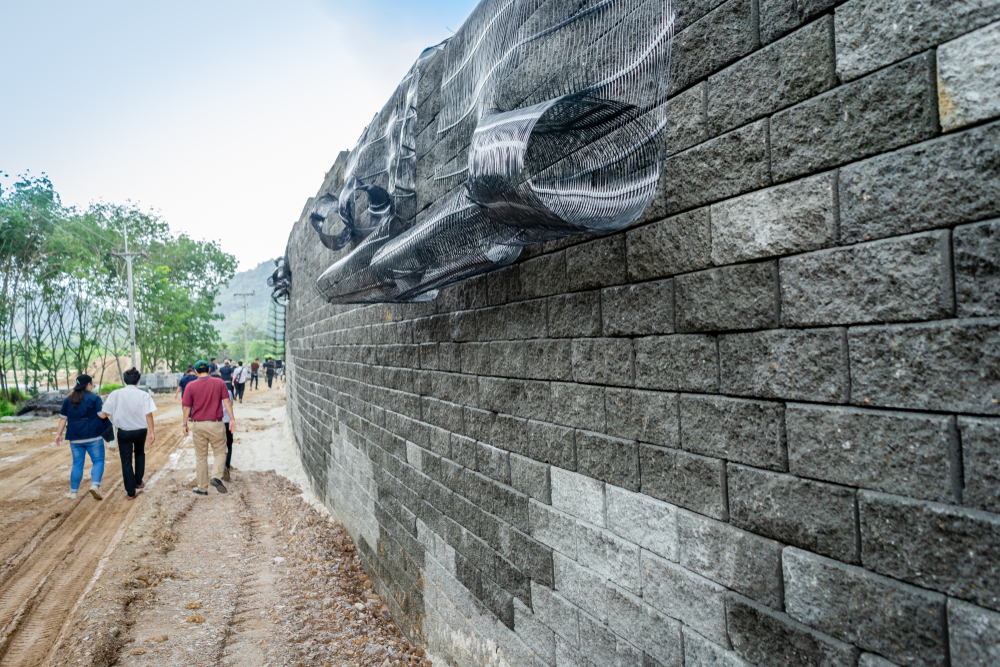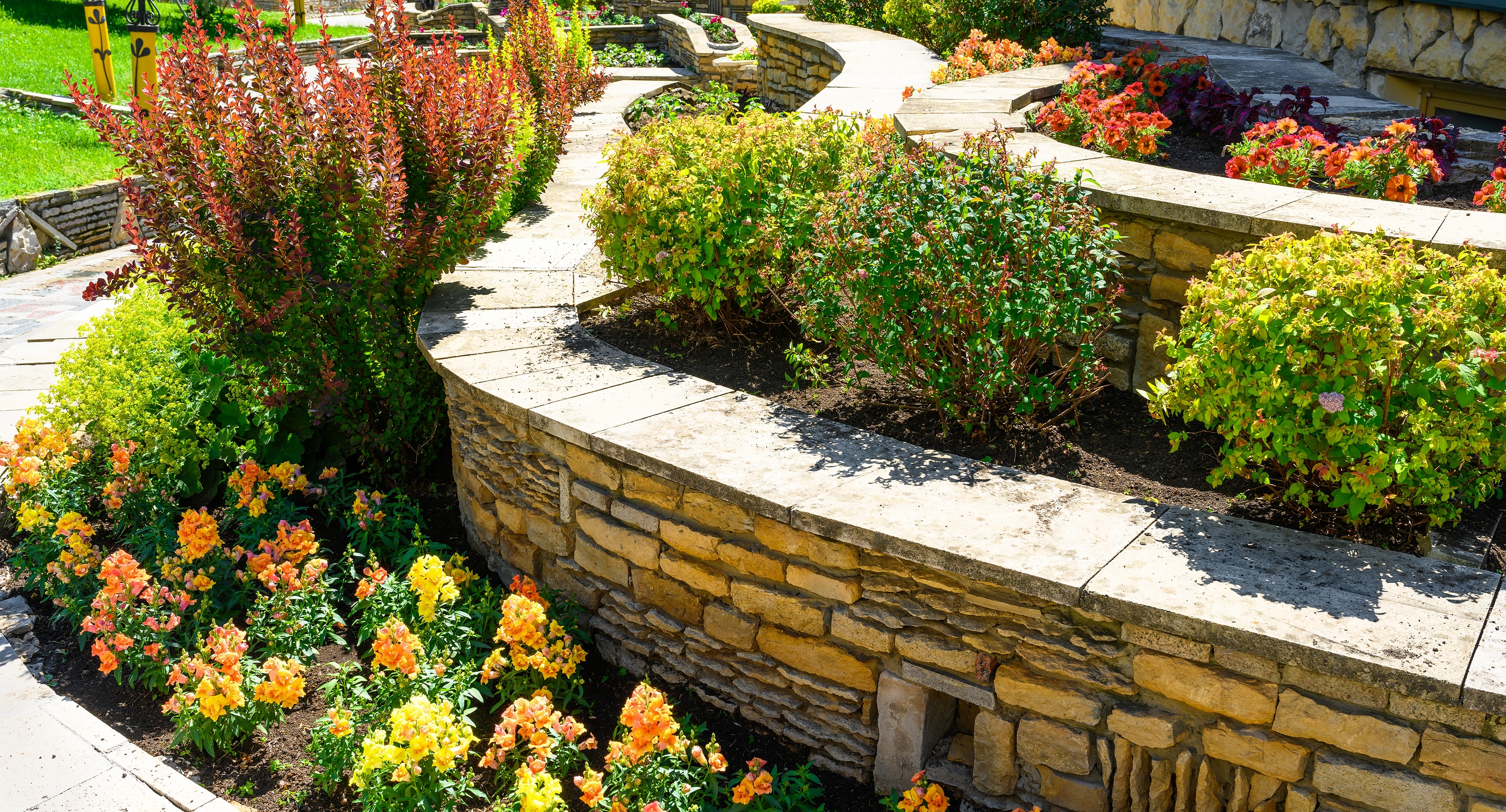Why OKC Precision Retaining Walls benefit structural developments
Trick Considerations for Structure Reliable Retaining Walls in Your Backyard
When you're considering developing a retaining wall in your backyard, it's essential to assume about several essential aspects. The wall surface's purpose, the products you'll utilize, and the certain soil problems can all impact its effectiveness and durability.
Recognizing the Purpose of Your Retaining Wall
When you assume about developing a preserving wall, consider its main purpose: stabilizing soil and avoiding erosion. Retaining walls offer necessary assistance for sloped landscapes, aiding to keep dirt stability. You'll discover they're crucial in areas where water overflow might otherwise get rid of soil, leading to pricey fixings and landscape damages.
By keeping back planet, these walls produce degree surface areas for yards, patios, or paths. This not just improves your lawn's aesthetics but likewise promotes better water drainage, lowering water merging in unwanted areas. If you're managing high inclines, a well-constructed retaining wall can stop landslides, making sure security for you and your building.
Inevitably, understanding the purpose of your retaining wall will certainly assist your style decisions and help you create a functional, sturdy framework that meets your demands. So, take a minute to assess your landscape; it'll pay off over time.
Choosing the Right Products
When picking materials for your retaining wall, you'll wish to think about longevity, looks, and expense. Each variable plays a necessary function in ensuring your wall stands the examination of time while looking terrific and fitting your spending plan. Allow's check out just how to make the very best selections for your project.
Product Resilience Aspects
Picking the ideal materials is essential for the longevity and efficiency of your retaining wall surface, given that their toughness directly affects the wall surface's ability to hold up against environmental anxieties. Beginning by considering your neighborhood environment; materials like concrete and rock withstand dampness and temperature variations well. If you reside in a location prone to hefty rainfalls, go with products with good water drainage residential properties, like gravel or porous blocks, to stop water build-up.
Additionally, think of the dirt problems on your residential or commercial property. Some materials do far better in details soil types, so it is necessary to match them as necessary. Lastly, be mindful of potential wear from insects or erosion. Picking sturdy products guarantees your retaining wall stands solid, shielding your backyard for many years ahead.
Visual Layout Selections
Resilient materials not just ensure your retaining wall surface's structural stability yet likewise play a key duty in its visual allure. Don't forget about the wall surface's form-- curved walls can develop a softer appearance, while straight lines can really feel much more structured. By very carefully selecting products that straighten with your aesthetic vision, you'll boost your outdoor space while guaranteeing your wall stands solid versus the elements.
Cost-Effectiveness Analysis
Picking the appropriate materials for your retaining wall surface isn't practically appearances; it's likewise essential for your budget plan. When selecting products, take into consideration both upfront expenses and lasting sturdiness. Concrete blocks may be more expensive at first, however their long life can conserve you cash on repairs. On the other hand, hardwood can be more inexpensive however might call for replacement quicker.
Do not neglect to variable in upkeep expenses. Some products, like natural stone, can add charm and need less upkeep, while others may need routine treatments
Eventually, evaluate the pros and cons of each choice against your budget plan and the wall's intended purpose. Investing sensibly in products now can protect against costly issues in the future. Select products that balance expense and efficiency properly.
Analyzing Soil Problems and Drain
As you start your project, examining dirt conditions and water drainage is crucial for the success of your retaining wall surface. Sandy dirt drains well but lacks security, while clay soil can keep moisture, leading to push on your wall.
Next, evaluate the slope of your backyard. If water naturally moves towards your wall, you'll require to execute a drainage option to stop disintegration and pressure build-up. Think about setting up perforated pipes or crushed rock backfill behind the wall surface to help with drainage.
Lastly, observe any type of nearby trees or plants; their roots can influence soil stability. By recognizing your soil conditions and carrying out correct drain, you'll develop a solid structure for your retaining wall surface that stands the test of time.
Abiding With Local Building Regulations
Before you start developing your retaining wall surface, you need to research study local guidelines to ensure conformity. It's vital to comprehend what allows you must obtain, as this can save you from expensive penalties or needing to redo your work. Taking these steps seriously will assist you construct a safe and effective structure.
Research Study Local Laws
Comprehending local policies is vital when planning your retaining wall task, specifically considering that developing codes can vary significantly by location. Begin by consulting your local structure division or municipality to find out about particular needs. Look for standards on wall height, materials, water drainage systems, and architectural stability. Many locations have limitations on the kinds of materials you can make use of and how high you can develop. You'll also wish to think about the zoning laws that might impact your project. Overlooking these guidelines can lead to pricey fines or the demand to renovate your job. By doing your research study upfront, you can assure your retaining wall surface meets all required codes and blends effortlessly into your lawn.
Get Necessary Licenses
As soon as you have actually investigated neighborhood policies, the following action is to obtain the needed authorizations for your retaining wall surface project. This process warranties your wall surface abides by structure codes and safety and security standards. Reach out to your regional structure authority to figure out what permits you need. They may need details plans or engineering evaluations, specifically for bigger walls. Be prepared to send comprehensive drawings, consisting of measurements and products. Do not forget to check if your task influences drainage or bordering get redirected here residential properties, as these factors might require additional licenses. Protecting the ideal authorizations can save you from costly fines or having to dismantle your wall later on. Bear in mind, following the rules currently will certainly bring about a smoother building and construction experience.

Planning the Layout and Aesthetics
As you start intending the design and visual appeals of your retaining wall surface, think about how it will certainly balance with the bordering landscape. Consider the products you'll utilize-- rock, block, or concrete-- and how they'll complement your home's style and the natural environments in your lawn. Choose shades and textures that mix perfectly with existing attributes like outdoor patios, paths, or gardens.
Following, visualize the wall surface's shape and elevation. Curved walls can soften an inflexible landscape, while straight lines may share a more modern-day look. Do not forget to integrate plants and plant around the wall for an all-natural touch; this can enhance its charm and integrate it into the setting.
Lastly, bear in mind functionality. Your style needs to not only be aesthetically pleasing but also offer its purpose successfully. By attentively planning these aspects, you'll develop a keeping wall surface that boosts your lawn's elegance while fulfilling its structural function.
Computing Height and Thickness Demands
To construct a sturdy retaining wall, you require to properly calculate its height and thickness demands based upon the dirt conditions and the height of the slope it will sustain. Start by assessing the incline's angle and the sort of soil, as various dirts apply differing quantities of pressure.
For walls over four feet high, think about a thickness of at least 12 inches. If the wall is taller, enhance the thickness proportionally to preserve stability.
Next, determine the height of the wall surface by gauging the upright range it requires to preserve. For every single foot of elevation, you must commonly prepare for a thickness of one-third of the wall surface's elevation.
Constantly keep in mind to make up added variables like drainage and backfill, which can affect your wall surface's layout. Correct estimations currently ensure your retaining wall surface stands strong anonymous and lasts for many years to find.
Maintenance and Longevity Considerations
While maintaining your retaining wall surface could appear like a low concern, overlooking it can result in significant issues over time. Normal examinations are important; look for cracks, bulges, or any kind of indicators of water damage. Dealing with these problems early can conserve you from expensive repairs later on.
Maintain an eye on drain systems, also. Blocked drains can create water to develop up, exerting stress on your wall surface and compromising its security. Clear debris and guarantee correct flow to maintain durability.
You may additionally intend to assess sealing your wall surface to safeguard it from moisture and weathering. Depending upon the material, this may require reapplication every couple of years.
Lastly, landscaping around your wall surface can support its stability. Avoid growing large trees close by, as their roots can threaten the foundation. With aggressive maintenance, your retaining wall surface can serve you well for many years to come.

Often Asked Concerns
Can I Construct a Retaining Wall by Myself, or Should I Hire an Expert?
You can definitely develop a preserving wall yourself if you have the right devices and expertise. Working with a specialist guarantees it's done properly, particularly for bigger or even more complex structures. Consider your skill level before making a decision.
What Are one of the most Typical Errors Made When Structure Retaining Walls?
When constructing retaining walls, you might neglect appropriate water drainage, miss using the best materials, or disregard support. These usual blunders can lead to architectural failing, so take your time and strategy meticulously to stay clear of concerns.
Just how Do I Know if My Retaining Wall Requirements Support?
You'll know your retaining wall needs support if you observe fractures, leaning, or bulging. Check for water pooling behind it or soil erosion near the base. Address these signs immediately to protect against more damages.
What Plant kingdom Appropriate for Landscaping Around a Retaining Wall?
When landscape design around a maintaining wall surface, think about utilizing low-maintenance plants like succulents, ornamental grasses, or slipping ground covers - OKC Precision Retaining Walls. They'll grow in those problems and add Visit This Link charm while avoiding soil erosion around your wall surface
Just How Can I Stop Erosion Around My Retaining Wall?
To protect against erosion around your retaining wall surface, you can plant ground cover, use compost, and set up drainage systems. Frequently look for water build-up and change landscaping to reroute overflow far from the wall surface.